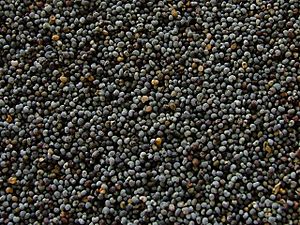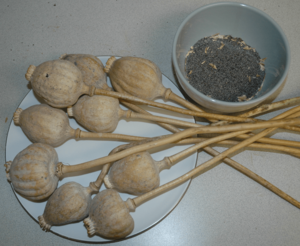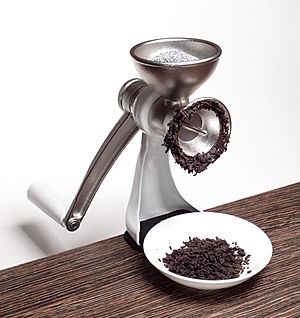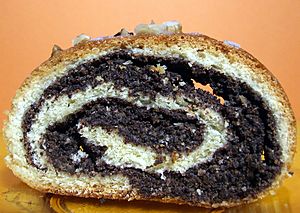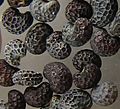Poppy seed facts for kids
Poppy seeds are tiny, kidney-shaped seeds that come from the opium poppy plant (Papaver somniferum). People have been collecting these seeds from dried seed pods for thousands of years. Today, poppy seeds are still very popular in many countries, especially in Central Europe and South Asia. They are often used whole or ground up in many foods, like pastry and bread. You can also press them to get poppyseed oil.
Contents
History of Poppy Seeds
Poppy seeds have a long history! Ancient medical writings from many old civilizations mention them. For example, an Egyptian scroll called the Ebers Papyrus, written around 1550 BC, said that poppy seeds could help people relax.
The Minoan civilization, which lived on the island of Crete a very long time ago (from about 2700 to 1450 BC), grew poppies for their seeds. They even used them in a special mix to help calm crying babies. The Sumerians, another ancient civilization, also grew poppy seeds.
What Poppy Seeds Look Like
Poppy seeds are super small, less than a millimeter long. They are shaped like tiny kidneys and have a bumpy surface. It takes about 3,300 poppy seeds to weigh just one gram!
The seeds from other types of poppy plants are not usually eaten. These poppies are grown mostly for their beautiful flowers. If you want to grow poppies, annual and biennial types are a good choice because they are easy to plant from seeds directly in the ground, even in January. For example, the California poppy (Eschscholzia californica) is a bright orange wildflower that grows in the Western United States.
Where Poppy Seeds Are Grown
| Poppy seed production (tonnes) | ||
|---|---|---|
| Country | 2018 | 2014–2018 average |
| 26,991 | 21,479 | |
| 13,666 | 22,739 | |
| 12,360 | 11,812 | |
| 4,514 | 5,467 | |
| 3,800 | 6,047 | |
| Source: FAOSTAT of the United Nations | ||
In 2018, the world produced about 76,240 tonnes of poppy seeds. Turkey was the biggest producer, making 35% of the world's total. The Czech Republic and Spain were also major producers.
Sometimes, because poppy seeds can be a bit expensive, they are mixed with seeds from another plant called Amaranthus paniculatus. These seeds look very similar to poppy seeds.
Poppy Seed Nutrition
| Nutritional value per 100 g (3.5 oz) | |
|---|---|
| Energy | 2,196 kJ (525 kcal) |
|
28.13 g
|
|
| Sugars | 2.99 g |
| Dietary fiber | 19.5 g |
|
41.56 g
|
|
| Saturated | 4.517 g |
| Monounsaturated | 5.982 g |
| Polyunsaturated | 28.569 g |
|
Protein
|
21.22 g
|
| Vitamins | Quantity
%DV†
|
| Vitamin A equiv.
beta-Carotene
lutein zeaxanthin
|
0%
0 μg0 μg
|
| Vitamin A | 0 IU |
| Thiamine (B1) |
74%
0.854 mg |
| Riboflavin (B2) |
8%
0.100 mg |
| Niacin (B3) |
6%
0.896 mg |
| Pantothenic acid (B5) |
0%
0 mg |
| Vitamin B6 |
19%
0.247 mg |
| Folate (B9) |
21%
82 μg |
| Choline |
11%
52.1 mg |
| Vitamin C |
1%
1 mg |
| Vitamin E |
12%
1.77 mg |
| Vitamin K |
0%
0.0 μg |
| Minerals | Quantity
%DV†
|
| Calcium |
144%
1438 mg |
| Copper |
0%
0 mg |
| Iron |
75%
9.76 mg |
| Magnesium |
98%
347 mg |
| Manganese |
109%
2.285 mg |
| Phosphorus |
124%
870 mg |
| Potassium |
24%
719 mg |
| Selenium |
0%
0 μg |
| Sodium |
2%
26 mg |
| Zinc |
74%
7.0 mg |
| Other constituents | Quantity |
| Water | 5.95 g |
|
Link to USDA Database entry
|
|
| †Percentages estimated using US recommendations for adults. | |
Poppy seeds are packed with energy! A 100-gram serving gives you 525 calories. They are also a great source of important nutrients like thiamin, folate, and several essential minerals. These minerals include calcium, iron, magnesium, manganese, phosphorus, and zinc. Poppy seeds are made up of 6% water, 28% carbohydrates, 42% fat, and 21% protein.
Poppy Seed Food Products
Whole Seeds
Whole poppy seeds are often used as a spice or a decoration on many baked goods. In North America, you can find them in and on foods like poppyseed muffins, rusk, bagels (like the Montreal-style bagel), bialys, and cakes.
Poppy seeds can also be used like sesame seeds. They are sometimes added to hamburger buns or made into candy bars. These candy bars are made by boiling the seeds and mixing them with sugar or honey. This is common in the Balkans, Greece, and countries that were once part of the Austro-Hungarian Empire.
The color of poppy seeds can be important for different dishes. Some people prefer slate-blue seeds from Holland. For thickening some foods, white poppy seeds are chosen because they don't change the food's color much. In other dishes, black poppy seeds are used for a strong color. Blue poppy seeds are popular in German and Polish breads and desserts.
Poppy Seed Paste
You can grind poppy seeds using a mortar and pestle or a small electric grinder. There are also special poppy seed grinders that make a smooth, less oily paste.
This poppy seed paste is used as a filling in pastries. Sometimes, it's mixed with butter or milk and sugar. This ground filling is used in poppy seed rolls and some croissants. It can be flavored with lemon or orange zest, rum, and vanilla. Raisins, heavy cream, cinnamon, and chopped almonds or walnuts can also be added. For sweet baked goods, you can use jam or syrup instead of sugar. Freshly ground poppy seeds make the best-tasting pastry filling.
You can also buy poppy seed paste in cans. Since poppy seeds have a lot of oil, commercial pastes usually contain sugar, water, and an emulsifier like soy lecithin to keep the paste from separating. They also have preservatives to keep them fresh.
Poppy Seed Oil
Poppy seeds are pressed to make poppyseed oil. This oil is valuable and used in cooking and other industries.
Other Uses
Poppy seeds are often used as bird seed. When used for birds, they are usually called maw seeds.
Poppy Seeds in Different Cuisines
Poppy seeds are used in many different cuisines around the world.
European Cuisine
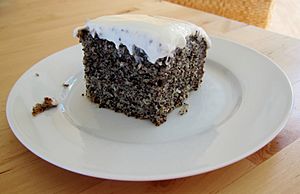

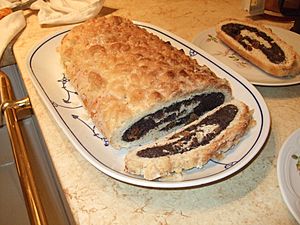
Across Europe, buns and soft white bread pastries often have black and white poppy seeds sprinkled on top. Examples include cozonac, kalach, kolache, and kołacz.
The seeds of the Czech blue poppy are very popular in Central and Eastern Europe. The sugared, ground seeds are eaten with pasta. They are also boiled with milk and used as a filling or topping for sweet pastries. People grind the seeds at home with a special mill or buy them already ground.
Blue poppy seeds are widely used in Austrian, Croatian, Czech, Danish, German, Hungarian, Lithuanian, Polish, Romanian, Russian, Serbian, Slovak, Slovenian, Turkish, and Ukrainian foods.
Countries that were once part of Yugoslavia, like North Macedonia, Serbia, Croatia, and Bosnia, have a long tradition of making poppy seed pastries. These include štrudla, baklava, and pajgle, as well as dishes like pasta with poppy seeds. In Slovenia, blue poppy seeds are used in traditional dishes like prekmurska gibanica and makova potica.
In Poland, Hungary, Lithuania, and Eastern Slovakia, a special dessert is made with poppy seeds for Christmas Eve dinner. The seeds are ground and mixed with water or milk. Then, small round yeast biscuits are soaked in this poppy seed 'milk' and served cold.
In Central Europe, poppy strudel is very popular, especially around Christmas. In Germany, Poland, and countries that were part of the former Austro-Hungarian Empire, poppy seed pastries called Mohnkuchen are often eaten during Christmas time. Some recipes for Mohnstriezel use poppy seeds soaked in water or boiled in milk. A recipe for Ukrainian poppyseed cake suggests soaking the seeds in boiling water, then straining them and soaking them in milk overnight.
Jewish Cuisine
In Eastern European Jewish cuisine, pastries filled with black poppy seeds and a sugary paste are traditional during Purim. This holiday happens about a month before Passover. Popular pastries include poppy seed kalács and hamantashen, sometimes called beigli. Poppy seed hamantashen used to be the main traditional food eaten by Ashkenazi Jews at Purim. Poppy seed pastries are common in Jewish bakeries and delis across the United States.
Indian Cuisine
In Indian cuisine, white poppy seeds are added to recipes to make them thicker, add texture, and give flavor. They are often used in korma. Ground poppy seeds, along with coconut and other spices, are mixed into a paste and added while cooking.
Poppy seeds are used in many regional Indian dishes. One popular dish is aloo posto, which means potato and poppy seeds. It's made by cooking ground poppy seeds with potatoes to create a smooth, rich dish, often eaten with rice. There are many versions of this dish, where other ingredients like onions (penyaj posto), pointed gourd (potol posto), Ridged Luffa (jhinge posto), chicken (murgi posto), and prawns (chingri posto) replace or are added to the potatoes.
Chadachadi is a dish from Bengali cuisine that includes long strips of vegetables, sometimes with leafy green stalks. It's lightly seasoned with spices like mustard or poppy seeds and flavored with a phoron. Another dish involves grilling patties made from posto, sometimes frying them (postor bora). You can also simply mix uncooked ground poppy seeds (kancha posto) with mustard oil, chopped green chili peppers, fresh onions, and rice. Kacha posto bata (uncooked poppy seeds paste) with mustard oil is very popular in West Bengal and Bangladesh. Poppy seeds are also widely used in Kashmir as a topping on various breads, especially kulcha.
Poppy seeds, along with tulsi (basil) seeds, are added to drinks like thandai, sharbat, milkshakes, rose milk, almond milk, and khus khus milk.
Images for kids


